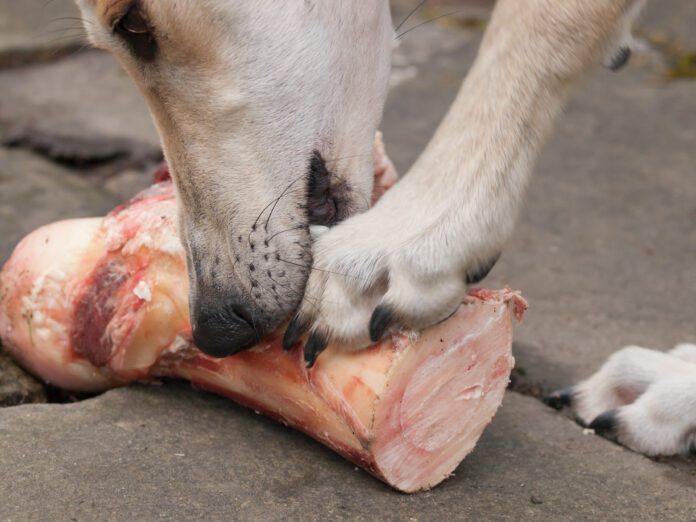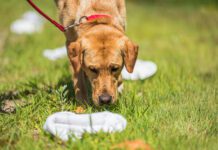People have been giving raw meaty bones to dogs ever since the two species teamed up as hunters and companions. In the 20th century, the convenience of commercial canned food and kibble took precedence in the canine diet, but many people continue to give raw bones for recreational chewing, dental benefits, or as part of a raw diet.
However, there’s disagreement on whether it’s safe or beneficial to give raw bones to dogs. Veterinarians generally recommend against them, having treated dogs with broken teeth, obstructions or intestinal perforations related to chewing or ingesting bones. Most owners who give them cite dental and mental benefits. Here’s what to consider about raw bones for dogs.
Pros of Raw Bones for Dogs
Chewing on bones can do a great job of removing plaque and tartar off teeth, keeping fangs gleaming and breath fresh. That’s more than a cosmetic benefit. Plaque is a soft biofilm and makes a cozy home base for bacteria to attack the gums, inflaming them and causing damage to periodontal tissues. The mouth is the gateway to the rest of the body, and studies have established a statistically significant association between periodontal disease and cardiac, kidney, and liver disease in dogs.
Dog lovers who give bones say chewing aids dental health and reduces the necessity for professional veterinary cleanings, which can be expensive. Chewing bones also provides a mental and physical workout for dogs, especially dogs who are “busy” and food-oriented.
Cindy Steinle has American Bulldogs, notorious for poor dental health. Chewing marrow bones keeps her dogs’ teeth clean and their minds occupied, she says.
Risks of Eating Bones
Veterinarians, who see the different ways bones can go wrong, usually aren’t fans.
“I’m sure for every thousand dogs that get those bones, there’s only one or two that have a problem, but it’s an avoidable problem,” says Tony Johnson, DVM, DACVECC, an emergency and critical care specialist in Chicago.
Physical hazards include shards that can poke into the mouth or tongue or pierce the esophagus, cause choking, or perforate or obstruct the stomach or intestines. Broken teeth and constipation are additional concerns. And there’s no way to predict if or when a dog will have a problem with bones.
Collie owner Rosemary George used to give her dogs lamb femurs, but the approach of Hurricane Sandy in 2012 coincided with one of her dogs exhibiting worrisome signs of what appeared to be bloat or an intestinal blockage. “Because everything was shut down in advance of the hurricane, we had to go to an emergency clinic that had a generator in case power was lost,” she says. “Everything ended up all right in the end. It wasn’t bloat and they were able to clear the blockage of bone fragments without surgery, but I was unable to pick him up for two days because of the hurricane and its aftermath. That turned out to be a very, very expensive lamb femur.”
Having something to chew is certainly important, says Ross Massimiano, DVM. “The chewing action can help keep teeth cleaner. I think of chewing as brushing, in a way, for dogs. Something to chew is important to have.”
He’d just prefer that it not be a natural bone. Besides the aforementioned risks, he worries about environmental contamination in homes with children, women who are pregnant, or individuals who are immunocompromised.
The increasing incidence of avian influenza (H5N1) in cattle and cats also has him concerned about canine exposure to raw meaty beef bones. While currently cats—both domestic and wild—are at far greater risk of avian influenza than dogs, Dr. Massimiano worries that a random mutation could affect dogs as well.
Choosing Raw Bones for Dogs
When giving bones, take into account the dog’s temperament, size, health, and lifestyle. Here’s what to know about choosing the right ones for your dog and where to get them.
The first thing to consider is how your dog eats. Gulpers may simply not do well with bones. They’re not going to get the dental or meditative benefits and may be more prone to choking.
Bones should be larger than the dog’s mouth so there’s no possibility of the dog swallowing them. Pay attention to how much the dog gnaws away over time and toss them when they get too small.
Avoid giving bones to dogs who are immunocompromised. That means very young dogs, who don’t have fully developed immune systems; dogs undergoing chemotherapy or steroid treatment or with chronic health conditions; and senior or geriatric dogs, who may have weakened immune systems or poor dental health.
Give recreational bones separately from meals and only when you’re able to consciously supervise chewing. Take them up after about 10 minutes (before you get bored), clean them, and freeze until the next use.
Types of dog bones that generally come to mind for recreational chewing are marrow and knuckle bones, especially if they still have attached meat, cartilage, fat, and connective tissue. They are sometimes referred to as “wreck bones,” though, for the broken teeth and other injuries they can cause.
Labrador owner Linda Rehkopf used to give her dogs raw marrow bones. Then one day her dog Story flipped a marrow bone over her bottom canines and around her jaw, like a donut. At the veterinary clinic, she put Story in a stand-stay and gave a “watch me” cue while the veterinarian chipped away at the bone with a bolt cutter. Afterward, the veterinarian advised no longer giving marrow bones unless they were longer than four inches.
If they’re the right size and the dog is supervised while chewing, marrow bones have some advantages. “They maintain scent and flavor, they’re washable, refillable and reusable, and they can be frozen,” Steinle says. “When you’re done with them, toss them in the garbage. They’re biodegradable, as well.”
When her pet-sitting clients ask about giving bones, Steinle suggests knuckle or marrow bones because it’s easier to monitor dogs chewing on them, but she recommends that people ease into giving them. Knuckles, in particular, require an adjustment period because more tissue remains on them, she says.
The fat in marrow-filled bones can cause diarrhea. Remove most of it before giving the bone, leaving only a small amount to entice the dog.
Heather Houlahan, who has English Shepherds running her small Pennsylvania farm, prefers to give soft, non-weight-bearing bones that the dog gnaws and consumes fully. Those types of bones include duck necks, chicken backs, and venison, sheep, and goat ribs. The bones are part of a varied homemade diet of meat and organs, vegetables, grains, kibble, canned dog food, and canned fish.
Unless, like Houlahan, you do your own butchering and hunting, the best source for raw meaty bones for dogs is from a butcher. Even if you don’t shop at a local butcher, the meat department at your grocery store may be able to provide you with the type of bones you’re looking for and grind chicken necks or backs for you.
Never give cooked or dried bones. They become brittle and are more likely to splinter and cause injury. Dr. Johnson is also not a fan of synthetic bones or rawhides, saying they have the same risk of causing choking or obstructions as raw bones. “My favorite toy is something that can’t be ingested at all, and my favorite treat is something that can be completely ingested,” he says. “Anything in between, you’re just asking for trouble.”
Proper Handling of Raw Bones
One of the arguments against giving bones is the risk of handling raw meat and transmission of food-borne pathogens. Take the same precautions you would in preparing hamburgers or roast chicken for yourself:
*Refrigerate or freeze raw bones until you give them.
*Use a cutting board that is reserved for use with your dogs’ food.
*Sanitize counters or cutting boards that bones have touched.
*Wash your hands thoroughly with soap and water after handling bones or raw meat. (This is especially important with poultry, which often carries salmonella bacteria.)
*Give bones outdoors or in an area that can be easily cleaned afterward.
Additional Safety Tips
- If your dog is new to bones, start slowly. For kibble-fed dogs, it can take time for their digestive system to adjust to the additional meat and fat.
- Encourage dogs to take their time chewing. Overly aggressive chewers may attempt to swallow bones.
- Avoid giving bones to dogs with severe periodontal disease. Chewing bones may be painful for them and they may be more prone to broken teeth, leading to infection, reluctance to eat, or tooth loss.
- Supervise, especially if your dog tends to gulp food without chewing. That behavior may carry over to bone chewing.
- Don’t let dogs crunch up bones and eat them. That’s when bone fragments can become wedged painfully between teeth or bone impactions and intestinal obstructions or perforations are likely to occur. Don’t hesitate to take your dog to the veterinarian if you suspect an obstruction or perforation. Signs of problems include unusual lethargy, vomiting, and diarrhea.
- To prevent fights or guarding behavior, never give bones to multiple dogs in the same area. Crate them in separate rooms or otherwise separate them.
- If your dog has food- or toy-guarding tendencies, it’s best not to give bones at all.
Lots of people give their dogs raw meaty bones with no ill effects and plenty of benefits. Consider your ability to recognize and handle a problem, including financially, and proceed accordingly.





